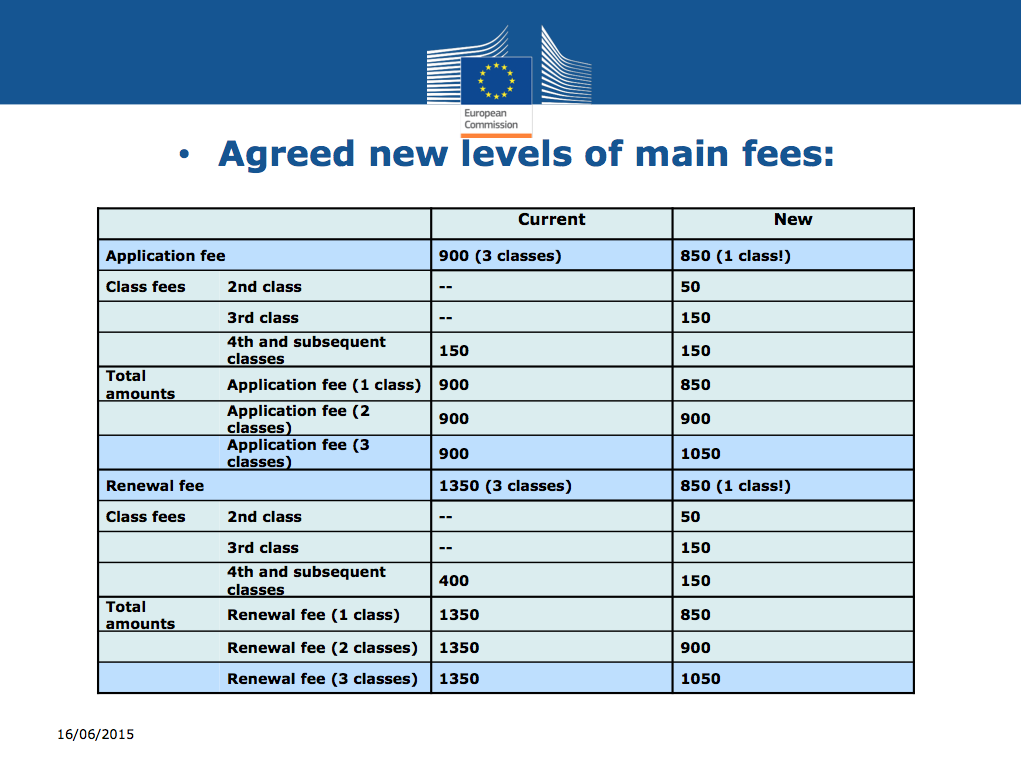The proposals for a new EU Trade Mark Directive and CTM Regulation were published last month, following discussions between the EU Commission, European Parliament and Council. The latest texts are not absolutely final, and further discussions are due to take place in the autumn before adoption probably early in 2016. However, there are not expected to be many further changes to the latest version.
The reforms are extensive: for example, the old Directive had 19 articles, but the new one has 57. Once implemented, the changes will affect everything from the names (OHIM will become the EU IP Office and CTM will become EUTM) and the fees payable, to the law on the scope of protection.
The MARQUES EU Trade Mark Reform Task Force has been monitoring the discussions since day one, and has also called for certain issues that affect trade mark users to be addressed. Below, members of the Task Force examine some of the main points of the reforms, and explain what MARQUES members need to be aware of now.
Fees and multiple classes: Article 44 TMD
 According to Article 44 of the Directive, Member States may provide for an additional fee for each class beyond the first class.
According to Article 44 of the Directive, Member States may provide for an additional fee for each class beyond the first class.
In line with this, the fees before OHIM will change. According to Annex I of the Regulation, the fee for the second class for an EU mark will be €50 and for each further class €150. Since at the same time the basic fee will be lowered by €50 (from €900 to €850 for electronic filings), the costs for filing an EU mark covering more than two classes will rise by €150 compared to the former CTM system. (The list of new fees, pictured right, is from the presentation given at the ECTA Annual Conference in June by by Tomas Lorenzo Eichenberg of the European Commission.)
The same new fee structure will apply to renewals (€850 basic fee, €50 for the second class and €150 for each further class), which is substantially lower than to the former CTM system (€1,350 basic fee, €400 for each class beyond three).
Unfortunately, MARQUES’ request to introduce in the Directive a requirement for all Member States to provide for multi-class applications has been ignored. Within the EU, Malta and Cyprus are single class jurisdictions, where all trade mark-related fees are charged per class.

Jochen Höhfeld, KSNH
Goods in transit: Articles 10(5) TMD and 9(5) CTMR
As MARQUES has urged, the draft Directive and Regulation propose a new right for trade mark proprietors to prohibit goods in transit which would be regarded as counterfeit in the Member State where they come under Customs supervision.
Brand owners will welcome the proposals, but the compromise text includes a proviso that this right will be lost if the declarant or owner of the goods proves that the proprietor would not be able to prevent the goods being put on the market in the country of final destination.
This raises the prospect of national courts having to determine potentially difficult questions of foreign law, but the burden of proof will be on the shipper of the goods to prove what is the country of final destination and that the brand owner has no relevant rights in that jurisdiction.

Ian Lowe, Nabarro
Administrative procedures: Articles 45 and 47 TMD
The requirement for all offices to provide administrative procedures for revocation and cancellation actions is to be welcomed, and is something that MARQUES had called for. Administrative procedures are simpler, faster and cheaper than court actions for both trade mark owners and third parties.
However, MARQUES would have preferred that these procedures had to be brought in as soon as possible, rather than within a seven-year transition period as has been agreed.
We also hope that the procedures in different offices will be harmonised from the outset. We would favour a convergence project to achieve this, using the best practices from member states that already have these procedures.

Tove Graulund, Graulund Consulting
Coexistence agreements: Article 5(5) TMD
MARQUES supported the amendment to Article 5(5) TMD adopted by the Parliament at its first reading regarding consents, in the sense that, if two trade mark owners agree to coexist, the Office should accept such an agreement.
For some reason, during the discussions the text of the article was amended to say that the Office “may” permit that registration not be refused or declared invalid where the owner of the earlier mark or right consents to the registration of the earlier mark. MARQUES insisted thereon that “may” should be amended to “shall”, which is the expression which has been finally reinstated.
This is positive for trade mark owners, as it gives more importance to what has been agreed between them, rather than leaving up to the Office to decide if it gives value to that agreement.
This is particularly important bearing in mind that in some countries there is ex officio citation of relative grounds. In the systems where there is no such examination there is in principle no need for consents, as it is usually sufficient not to file an opposition or to withdraw it for the earlier right owner not to block a new application.

Miguel Angel Medina, Elzaburu
Limitations on rights: Article 14 CTMR
The "use of signs or indications which are not distinctive" has been added to the list of cases where the proprietor shall not be entitled to prohibit a third party from using a sign in the course of trade (suggested amendments of Article 12 (1) (b) CTMR – Limitation of the Effects of a Trade Mark (new Article 14 (1) (b) CTMR)).
MARQUES would have preferred the wording "which are used in a descriptive manner" in order to avoid discussions as to whether the trade mark as such is descriptive.
However, when applying this provision, it should be kept in mind that on the one hand, the registered trade mark must be taken as being distinctive as long as it is registered, but that on the other hand, the same sign might not be distinctive if it is used by a third party in a descriptive way: such use should indeed remain free for third parties to use.

Petra Goldenbaum, CMS Hasche Sigle
Classification of goods and services: Article 28 CTMR and Article 40 TMD
Recital (35) of the Directive states that the designation and classification of goods and services should follow the same rules in all Member States and should be aligned to those applicable to EU marks. Accordingly, both Article 28 of the Regulation and Article 40 of the Directive implement the IP Translator judgment of the CJEU.
Thus, goods and services shall be identified with sufficient clarity and precision to enable the competent authorities and economic operators, on that sole basis, to determine the extent of the protection sought. The interpretation of general terms, including the general indications of the class headings of the Nice Classification, shall be limited to their literal meaning.
Unfortunately, harmonisation has not been reached for the past, i.e. for already registered trade marks: Article 28 (8) of the Regulation states that “proprietors of EU marks applied for before 22 June 2012 which are registered in respect of the entire heading of a Nice class may declare that their intention on the date of filing had been to seek protection in respect of goods or services beyond those covered by the literal meaning of the heading of that class, provided that the goods or services so designated are included in the alphabetical list for that class of the edition of the Nice classification in force at the date of filing. The declaration shall be filed at the Office within six months from the entry into force of the Regulation.”
But a similar provision is not included in the Directive. Therefore, with respect to old registrations, national practices will have to be observed in the Member States as well as before OHIM in all proceedings involving those rights. Fortunately, as a result of the first Convergence Programme project CP1, OHIM and the national offices have published a Common Communication on the Implementation of IP Translator (v1.2, 20 February 2014) in which the individual practices are listed.
While MARQUES had always pleaded – for clarity reasons – for a retroactive application of the IP Translator criteria not only at OHIM but in all Member States (the former drafts under the Greek presidency had even considered this in both the Regulation and Directive), the current provisions follow OHIM’s proposal. At least upon MARQUES’ intervention further provisions on intermediate rights were included in Article 28 (8a) of the Regulation for those cases where the register is amended upon the proprietor’s request.
In any case, it is important that users revisit their CTM portfolio now to identify those marks which recite one or more entire class heading, and they need to observe the six-month time limit if they wish to broaden the scope of protection to those terms that are not literally covered by the general indications used in the class heading but which were included in the alphabetical list for that class of the edition of the Nice Classification in force at the date of filing.

Jochen Höhfeld, KSNH
Certification marks: Article 74b CTMR
As is well known, the new CTM regulation will introduce the EU certification mark. Currently at the EU level we only have Community collective marks in addition to the regular Community trade marks. Member States have the possibility of having certification or guarantee marks at national level: some have them and some do not.
The origin of the goods has traditionally been considered as one of the characteristics that could be certified by means of a certification mark and is one of the characteristics that is traditionally expressly mentioned in articles that deal with certification marks. Nevertheless, this reference has been deleted in the last version of the draft Article 74b CTMR.
MARQUES would have liked to have seen this reference in the text as usual, as certification marks are generally considered as a useful tool for protecting GIs and the deletion may lead to some questions as to its interpretation.
It is likely that the momentum gained by the work for a possible new EU regulation on non-agricultural foods at EU level means that the EU institutions intend to keep the “geographical origin” away as much as possible from the trade mark field.

Miguel Angel Medina, Elzaburu
Opposition procedure: Article 4 TMD and Article 7 CTMR
MARQUES is pleased that the section for absolute grounds for refusal or invalidity now covers designations of origin and geographical indications; protection of traditional terms for wine; protection of traditional specialities guaranteed; and plant varieties (Article 4 TMD and 7 CTMR). MARQUES supports the option to allow for oppositions based on bad faith as an absolute ground for refusal (Article 4.3 TMD).
MARQUES also welcomes the proposal for Article 8(4) CTMR, which entitles one to file an opposition based on a designation of origin or geographical indication. The amendment now makes it clear that only the association or person authorised for it is entitled to file opposition, and it is consistent with Article 5 (3) (d) (ii) TMD.

Cristina Duch, Baker & McKenzie
Application and filing dates: Article 27 CTMR and Article 39 TMD
MARQUES is pleased to see that the filing date requirements were left unchanged. Applicants continue to have one month to pay the application fee (Article 27 EUTMR; Article 39 EUTMD).

Till Lampel, Harmsen Utescher
Evidence of use: Article 17 TMD
Regarding the five-year term to provide evidence of use in infringement proceedings, MARQUES has always been in favour of harmonising the time period in which the owner of an allegedly infringed trade mark has to furnish genuine use where the defendant requests such proof.
We are pleased to see that this period has indeed been harmonised in Article 17 EUTMD (five years preceding the date of bringing the action as provided in Article 16 EUTMD).

Till Lampel, Harmsen Utescher
Grouping of goods and services
MARQUES opposed the principle that applicants should be obliged to group goods and services according to the Nice Classification at the time of filing, as this can disadvantage non-expert applicants. This is an important point regarding access to the trade mark system, particularly for SMEs.
It is regrettable that this was not taken on board during the discussions. However, in practice, we hope that offices will take a reasonable approach and be aware of all users’ needs, including SMEs, providing assistance where necessary.

Tove Graulund, Graulund Consulting
Grace period: Article 16 TMD
In regard to the five-year grace period MARQUES persistently asked for clarity on the exact calculation of this period.
Although we primarily asked to have the end of the grace period be entered into the register, MARQUES is also pleased to learn that the new EUTMD accounts for the asked-for clarification in a slightly different way, namely by stipulating in Article 16 para 3a that the date of the commencement of the grace period shall be entered into the register. This will give the clarity that MARQUES asked for.

Till Lampel, Harmsen Utescher
Freedom of expression: Recital 21 CTMR
Recital 21 refers to the exclusive rights conferred by a European Union Trade Mark and also to the limitation of its effects. It is emphasised that all provisions of the CTMR should be applied in a way that ensures the full respect of fundamental rights and freedoms, in particular the freedom of expression.
In this context, reference is in particular made to uses of a trade mark made by third parties for the purpose of artistic expression. This should be considered as being fair as long as they are at the same time in accordance with honest practices in industrial and commercial matters.
This is to be welcomed. In practice, it will always be necessary to balance the freedom of expression on the one hand and the legitimate interests of trade mark owners on the other hand.

Petra Goldenbaum, CMS Hasche Sigle
Absolute and relative grounds: Articles 4 and 7 TMD
Article 4 (l) and Article 7 (1) (l) of the TMD introduce the right to oppose trade marks that consist of or reproduce “in their essential elements” earlier plant variety names. MARQUES has criticised this as we believe it more properly belongs in the relative grounds for refusal.
Additional wording has been added stipulating that the trade marks must be for plant varieties of the same or closely related species. This additional wording is in line with the sense of the provision, but we believe the provision is still in the wrong place and should not be included in the absolute grounds section.
Other than this addition, the provisions in relation to absolute grounds remain unchanged.
Regarding relative grounds, MARQUES has consistently supported the Commission’s proposal to abolish refusals based on ex-officio examination of relative grounds by national offices. We believe this is in the best interests of trade mark owners and applicants, and are disappointed that this was not included in the final version of the reform.

Sarah Bailey, Simmons & Simmons
Search reports
The Community search report has been made optional.
MARQUES had supported the Commission’s proposal to abolish national search reports for CTM applications and resisted an alternative proposal that these search reports be mandatory. In the end, national search reports will remain optional.

Robert Guthrie, Osborne Clarke
Applications for declarations of invalidity: Article 53 CTMR
Article 53(1) CTMR confirms that the relevant point of time for the assessment of applications for declarations of invalidity, or counterclaims in infringement proceedings that are based on relative grounds, is the filing date or the priority of the later mark. MARQUES supported this clarification.
Although Article 8 TMD addresses the same issue, it provides that an application for a declaration of invalidity shall not succeed if it would not have been successful at the filing date or priority date of the later mark for three specific reasons, which, in summary, are:
a) the earlier trade mark could have been declared invalid because it had not yet acquired distinctive character;
b) the earlier trade mark had not yet become sufficiently distinctive to support a finding of a likelihood confusion within the meaning of new Article 5(1)(b); and
c) the ground of invalidity is new Article 5(3)(a) and the earlier right had not yet acquired the necessary reputation.
MARQUES suggested that the TMD should simply follow the approach of the CTMR and confirm that the relevant point of time for the assessment of declarations of invalidity that are based on relative grounds is the filing date or the priority of the later mark. The effect of the current drafting appears to be that in some circumstances an application for a declaration of invalidity will succeed even though it would not have succeeded at the filing date or priority date of the later trade mark. However, the wording of Article 8 TMD remains largely unchanged.

Robert Guthrie, Osborne Clarke
Intervening rights defence: Article 18 TMD and Article 13 CTMR
Article 18 TMD and Article 13a CTMR provide for a qualified intervening rights defence to trade mark infringement to owners of later filed trade mark registrations. The circumstances in which the defence applies vary depending on whether the later mark is an EU trade mark or national mark.
For both EU trade marks and national trade marks, the intervening rights defence will apply if the later mark cannot cannot be declared invalid because the proprietor of the earlier trade mark has acquiesced to the use of the later trade mark (Article 54(1) and (2) CTMR and Articles 9(1) and (2) TMD) – this is essentially the same as the acquiescence defence that existed previously – or the earlier trade mark could have been revoked for non-use at the filing date or priority date of the later mark (Article 57(2) CTMR and Article 48(3) TMD)
For EU trade marks only, the intervening rights defence will also apply if the owner of the earlier trade mark has expressly consented to the later trade mark's registration or has previously unsuccessfully applied for a declaration that the later mark is invalid and/or made a counterclaim on relative grounds (Article 53(4) CTMR).
For national trade marks only, the intervening rights defence will also apply if the later mark could not have been declared invalid at its filing date or priority date because the earlier mark had not at that stage: (i) acquired distinctive character; (ii) become sufficiently distinctive to support a finding of a likelihood confusion; or (iii) acquired the necessary reputation (where the ground of invalidity relied upon concerns the enhanced protection provided to marks with a reputation) (Article 8 TMD).
MARQUES had submitted that it seemed to be inherently undesirable that there were differences in when the intervening rights defence should apply that depend on whether that later mark is a European Union trade mark or a national trade mark.
We also raised concerns that the ability of proprietors of national trade marks to rely on an intervening rights defence in circumstances where the earlier trade mark had not yet acquired sufficient distinctive character or reputation when the later trade mark was filed, even if the earlier mark had acquired sufficient distinctive character or reputation by the time the use of the later mark was commenced, would provide a significant additional benefit to proprietors of national trade marks when compared to European Union trade marks.
However, the wording of the intervening rights defence provisions has remained largely unchanged.

Robert Guthrie, Osborne Clarke
Surrender mechanism and conversion
MARUES supports provisions to ensure that the mechanism of surrender of a trade mark is not abused in the context of revocation and invalidity proceedings. We note that OHIM has adopted a change in practice, reflected in its Guidelines, to apply the relevant safeguards where an attempt is made to surrender a CTM in revocation proceedings.
However, these safeguards do not apply in invalidity proceedings. MARQUES remains of the view that it would be preferable if both sets of proceedings were dealt with in the same way.
Regarding conversion, the manner in which national offices handle applications for conversion will not be harmonised by the reforms. This is of particular importance for the calculation of the five-year grace period for non-use. MARQUES hopes that further steps can be taken towards harmonising procedures on a practical level in the future.

Alessandra Romeo, MARQUES External Relations Officer
OHIM surplus and new tasks
MARQUES is pleased that the issue of the surplus has been resolved, as this discussion has been going on for more than 10 years. The proposals set out a clear mechanism whereby member states will receive 5% to 10% of OHIM’s income each year (ie, trade mark and design fees) if there is a surplus.
We welcome the fact that the Office must consult user representatives, in particular regarding the definition of cooperation projects and their evaluation. MARQUES will continue to provide input on this in its role as observer on the Management Board and the Budget Committee, and we will endeavour to monitor whether national offices are spending the money on improving trade mark and design services. MARQUES’ position has always been that money from IP fees should not be diverted to other parts of government.
MARQUES members should be aware that there is a safety valve that says that if a substantial surplus has been generated over five consecutive years there may be a transfer to the EU budget.
We also recognise that OHIM will be given more responsibilities as a result of the changes. In view of the draft Strategic Plan setting out the work for the next five years, MARQUES will monitor closely these activities. We note that OHIM’s role will develop and in some cases it will be given responsibilities in new areas.
However, MARQUES hopes that appropriate attention and funding is always given to the core business of administering trade mark and design applications and registrations.

Tove Graulund, Graulund Consulting
 Issue 055
Issue 055
 Issue 055
Issue 055